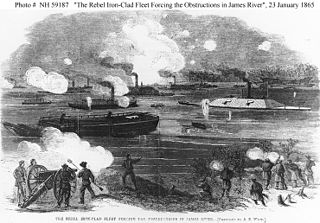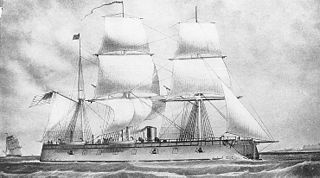
USS Housatonic was a screw sloop-of-war of the United States Navy, gaining its namesake from the Housatonic River of New England.

USS Keokuk was an experimental ironclad screw steamer of the United States Navy named for the city of Keokuk, Iowa. She was laid down in New York City by designer Charles W. Whitney at J.S. Underhill Shipbuilders, at the head of 11th Street. She was originally named Moodna, but was renamed while under construction, launched in December 1862 sponsored by Mrs. C. W. Whitney, wife of the builder, and commissioned in early March 1863 with Commander Alexander C. Rhind in command.

CSS Albemarle was a steam-powered casemate ironclad ram of the Confederate Navy, named for an estuary in North Carolina which was named for General George Monck, the first Duke of Albemarle and one of the original Carolina Lords Proprietor.

USS Galena was a wooden-hulled broadside ironclad built for the United States Navy during the American Civil War. The ship was initially assigned to the North Atlantic Blockading Squadron and supported Union forces during the Peninsula Campaign in 1862. She was damaged during the Battle of Drewry's Bluff because her armor was too thin to prevent Confederate shots from penetrating. Widely regarded as a failure, Galena was reconstructed without most of her armor in 1863 and transferred to the West Gulf Blockading Squadron in 1864. The ship participated in the Battle of Mobile Bay and the subsequent Siege of Fort Morgan in August. She was briefly transferred to the East Gulf Blockading Squadron in September before she was sent to Philadelphia, Pennsylvania for repairs in November.

CSS Virginia II was a Confederate Navy steam-powered ironclad ram laid down in 1862 at the William Graves' shipyard in Richmond, Virginia. Acting Constructor William A. Graves, CSN, was the superintendent in charge of her construction. In order to conserve scarce iron plating, he ordered the ship's armored casemate shortened from the specifications given in John L. Porter's original building plans; in addition, the ship's iron-plating, while six inches thick on the casemate's forward face, was reduced to five inches on her port, starboard, and aft faces. Due to the shortening of her casemate, the number of her cannon were reduced to a single 11" smoothbore, a single 8" rifle, and two 6.4" rifles.

The first USS Sassacus, a wooden, double-ended, sidewheel steamer in commission in the United States Navy from 1863 to 1865. She saw service in the American Civil War.

USS New Ironsides was a wooden-hulled broadside ironclad built for the United States Navy during the American Civil War. The ship spent most of her career blockading the Confederate ports of Charleston, South Carolina, and Wilmington, North Carolina, in 1863–65. New Ironsides bombarded the fortifications defending Charleston in 1863 during the First and Second Battles of Charleston Harbor. At the end of 1864 and the beginning of 1865 she bombarded the defenses of Wilmington in the First and Second Battles of Fort Fisher.

The USS Queen of the West was a sidewheel steamer ram ship and the flagship of the United States Ram Fleet and the Mississippi Marine Brigade. It was built at Cincinnati, Ohio in 1854. It served as a commercial steamer until purchased by Colonel Charles Ellet Jr. in 1862 and converted for use as a ram ship. The ship operated in conjunction with the Mississippi River Squadron during the Union brown-water navy battle against the Confederate River Defense Fleet for control of the Mississippi River and its tributaries during the American Civil War.

CSS David was an American Civil War-era torpedo boat. On October 5, 1863, she undertook a partially successful attack on USS New Ironsides which was participating in the blockade of Charleston, South Carolina.

William Augustin Webb was an American sailor and Mexican–American War veteran who resigned his United States Navy commission after more than 20 years of service to join the Confederate States Navy in the American Civil War. Webb was decorated for his service as Captain of the CSS Teaser, part of the James River Squadron, during the Battle of Hampton Roads (1862).

Laurent Millaudon was a wooden side-wheel river steamboat launched at Cincinnati, Ohio, in 1856 operating in the New Orleans, Louisiana, area, and captained by W. S. Whann. At the beginning of the American Civil War she was taken into service by the Confederate Navy as CSS General Sterling Price. On 6 June 1862, she was sunk at the Battle of Memphis. She was raised and repaired by the Union army, and on 16 June 1862 was moved into Union service as USS General Price and served until the end of the war.

The Battle of Plum Point Bend took place on the Mississippi River in Tennessee, U.S., between ships of the Confederate River Defense Fleet and the Federal Western Flotilla on May 10, 1862. Fighting for control of the Mississippi River had been ongoing since the prior year, and Federal forces had pushed downriver to Fort Pillow, which was 50 miles (80 km) on the river north of Memphis, Tennessee. The Federals had been using mortar boats to bombard Fort Pillow, and had settled into a regular routine. Each day, a single mortar boat guarded by an ironclad took a position further downriver to bombard the fort, while the rest of the fleet remained upriver. On the morning of May 10, the Confederates attacked, in hopes of capturing the guard ironclad and then surprising the rest of the Federal fleet.

USS Indianola was a casemate ironclad that served as a river gunboat for the Union Navy during the American Civil War. A side-wheel steamer also equipped with two screw propellers, Indianola was built in Cincinnati, Ohio in 1862 by Joseph Brown before being taken by Union authorities while still incomplete, in response to a perceived Confederate threat to Cincinnati. After completion, the vessel briefly served on the Mississippi River and the Yazoo River before being sent downstream of Vicksburg, Mississippi in February 1863, to support the naval ram USS Queen of the West, which was operating against Confederate shipping.
USS Hoyt was a steamer acquired by the Union Navy during the American Civil War. She was used by the Union Navy for various tasks, including those of a torpedo boat.
USS Althea was a screw steamer acquired by the Union Navy during the American Civil War. The Union Navy used it as a tugboat, a torpedo boat, and a ship's tender in support of the Union Navy blockade of Confederate waterways.

The Battle of Wassaw Sound was an American Civil War naval battle between the Confederate ram CSS Atlanta and the Passaic-class ironclad monitors USS Weehawken and USS Nahant and the gunboat USS Cimmerone, which took place on 17 June 1863 in Wassaw Sound, a bay in the present day state of Georgia. Atlanta ran aground while attempting to break the Union blockade, and after a short battle surrendered to the Union forces. Captain Rodgers became a national hero, and he was promoted to commodore and received the Thanks of Congress as a result of his decisive victory.

The Battle of Trent's Reach was one of the final major naval battles of the American Civil War. Beginning on January 23, 1865, a powerful flotilla of Confederate warships bombarded Fort Brady along the James River and engaged four Union Navy ships with the intention of breaking through the blockade to attack City Point, the base of General Ulysses S. Grant who was besieging Petersburg, Virginia. After two days of fighting, the rebels withdrew back up the river without completing their objectives.

CSS Squib, also known as CSS Infanta, was a Squib-class torpedo boat that served in the Confederate States Navy during the American Civil War. Squib was laid down in 1863, and was launched in early 1864. Her design was a form of launch armed with a spar torpedo. Initially serving on the James River as a flag of truce boat, she snuck into the Union Navy anchorage at Hampton Roads and attacked the steam frigate USS Minnesota early on the morning of April 9, 1864. Minnesota was damaged but not sunk, and Squib was able to escape back upriver. At an unknown time in mid-1864, Squib was moved by rail to the Wilmington, North Carolina, area, where she served on the Cape Fear River. Records of her service at Wilmington after November 1864 are not extent, but she may have resupplied a Confederate fortification during the Second Battle of Fort Fisher in January 1865. The next month, the Confederates withdrew from Wilmington, and Squib was scuttled off of Cape Fear.

The Squib class torpedo boats were built for the Confederate States Navy during the later stages of the American Civil War. After the torpedo boat CSS David attacked and damaged the ironclad USS New Ironsides, the Confederates continued building torpedo boats with hopes of breaking the Union blockade. Four vessels of the class – CSS Hornet, CSS Wasp, CSS Squib, and CSS Scorpion – were constructed in Richmond, Virginia, in 1864. All were armed with a single spar torpedo and were powered by steam engines. Squib damaged the gunboat USS Minnesota in an attack on April 9, 1864, and was later sent to Wilmington, North Carolina, where she was scuttled in February 1865. The other three vessels of the class were all part of the James River Squadron and participated in the Battle of Trent's Reach on the night of January 23 and 24, 1865. Scorpion ran aground during the battle, and was forced downriver and out of control after the tender CSS Drewry exploded on January 24. She was later captured by Union forces and may have been burned. Hornet was sunk in a collision with another vessel on January 27, and Wasp was scuttled on the night of April 2/3, as the Confederates were abandoning Richmond.

















